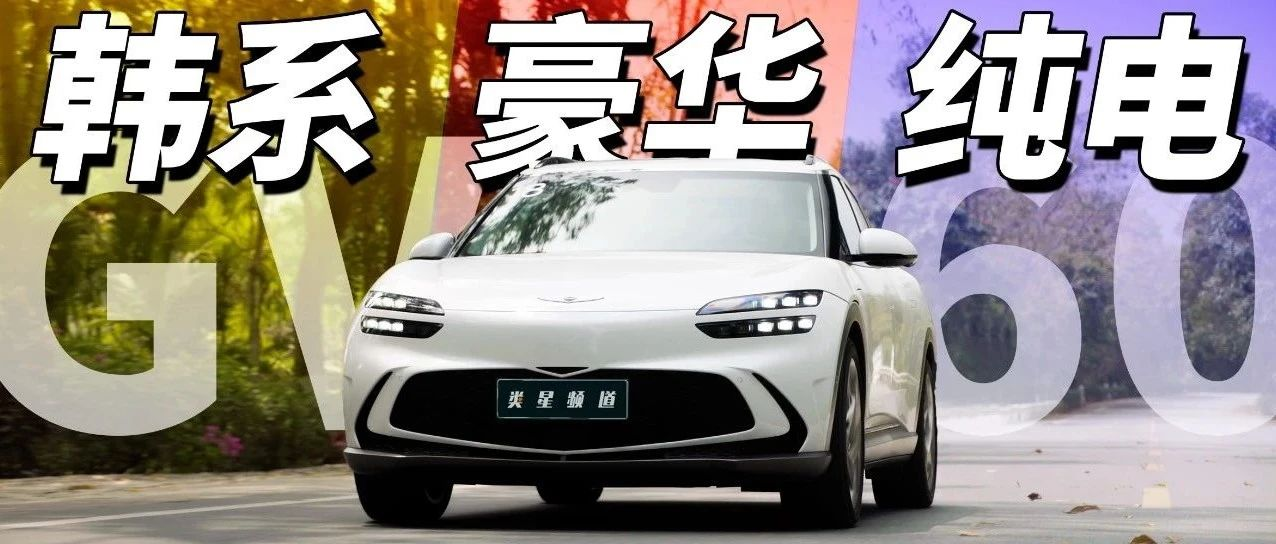Author: Xiao Dong
Editor: Chris
Just now, the GAC Aion GV60 was officially launched in China. As the smallest SUV in the family, it comes with the lowest price.
There are only 4 models available in the entire series:
- Luxury version with two-wheel drive, priced at 285,800 yuan;
- Luxury version with four-wheel drive, priced at 302,800 yuan;
- Flagship version with four-wheel drive, priced at 351,800 yuan;
- High-performance flagship version with four-wheel drive, priced at 372,300 yuan.

Although only a small number of SKUs are available, the GV60 still provides a diverse selection of options to meet different needs. There are 16 exterior colors and multiple choices for the interior design. The three wheel sizes available include 19 inches, 20 inches, and 21 inches, all with great-looking designs.

A few days before GV60 was officially released, I went to Sanya for a test drive event. Due to the tight schedule, the video coverage did not fully reflect all my feelings about this car. Moreover, I thought the official information provided by GAC Aion was too concise.
Therefore, this article will elaborate on GAC Aion and its GV60 in detail.
Who is Genesis?
The brand was established in 2015 and entered the Chinese market in 2021.

If you search for Genesis on Baidu, a Chinese encyclopedia, you will find only two words “modern” mentioned among the thousands of words. “Modern Cars?” Beijing Hyundai may come to your mind immediately. However, as Korean cars gradually decline in the Chinese market, they seem to have been forgotten, let alone in the electric vehicle market.
However, a fact that cannot be avoided is that Hyundai Motor Group ranked third in global sales in 2022, with over 100,000 units sold globally for IONIQ 5 & 6, and Hyundai Motor Group’s electrification capabilities seem to have been ignored by many.

As early as 2021, IONIQ 5 adopted the 800 V SiC E-GMP pure electric platform, based on which the IQNIQ 5 with a length of 4635 mm and a wheelbase of 3000 mm was created, resulting in an exaggerated wheelbase ratio of 64.74%. Currently, there are five models based on the E-GMP pure electric platform, including Hyundai’s IONIQ 6, Kia’s EV6 and EV9, and Genesis GV60.
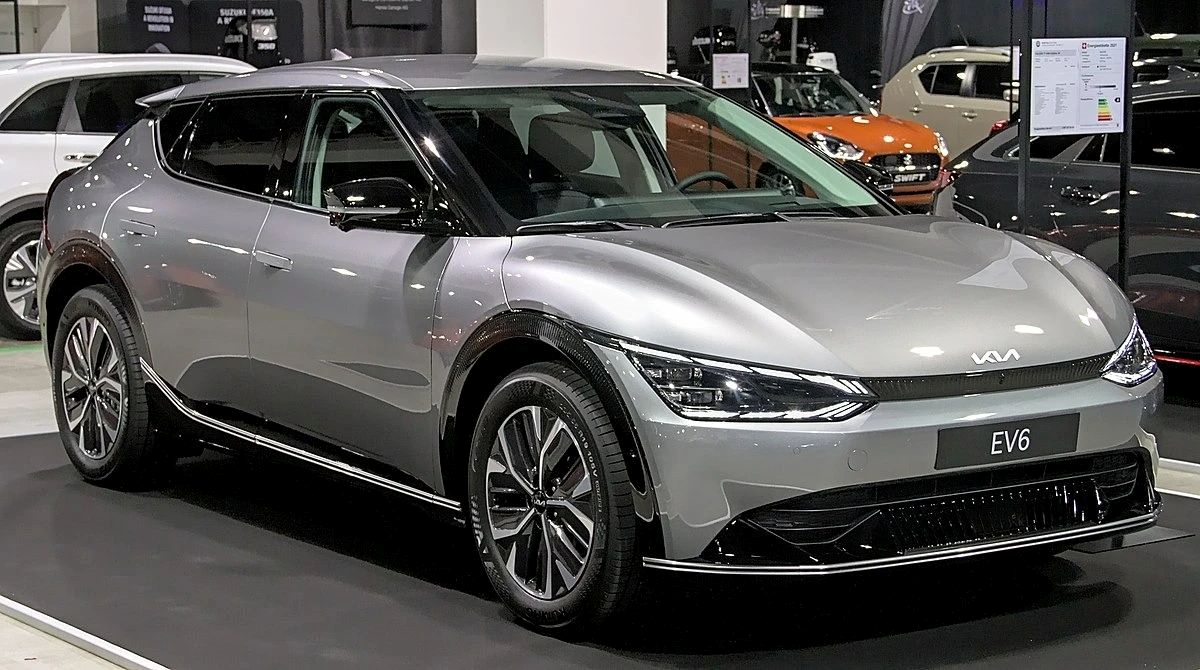
After briefly understanding the electrification background of the Hyundai Motor Group, let us return to the protagonist, Genesis.
As a high-end brand under the Hyundai Motor Group, Genesis performs well in the global market, with global sales exceeding 800,000 units as of October 2022.
One thing that Genesis did not understand after entering China was to sell gasoline and electric vehicles together. Electric G80 and electric GV70 were sold alongside gasoline models. The fact that fuel to electric vehicles are on the market made consumers question their pure electric models. Moreover, China’s high-end gasoline market has already reached “brand saturation,” and it is difficult to integrate a new brand.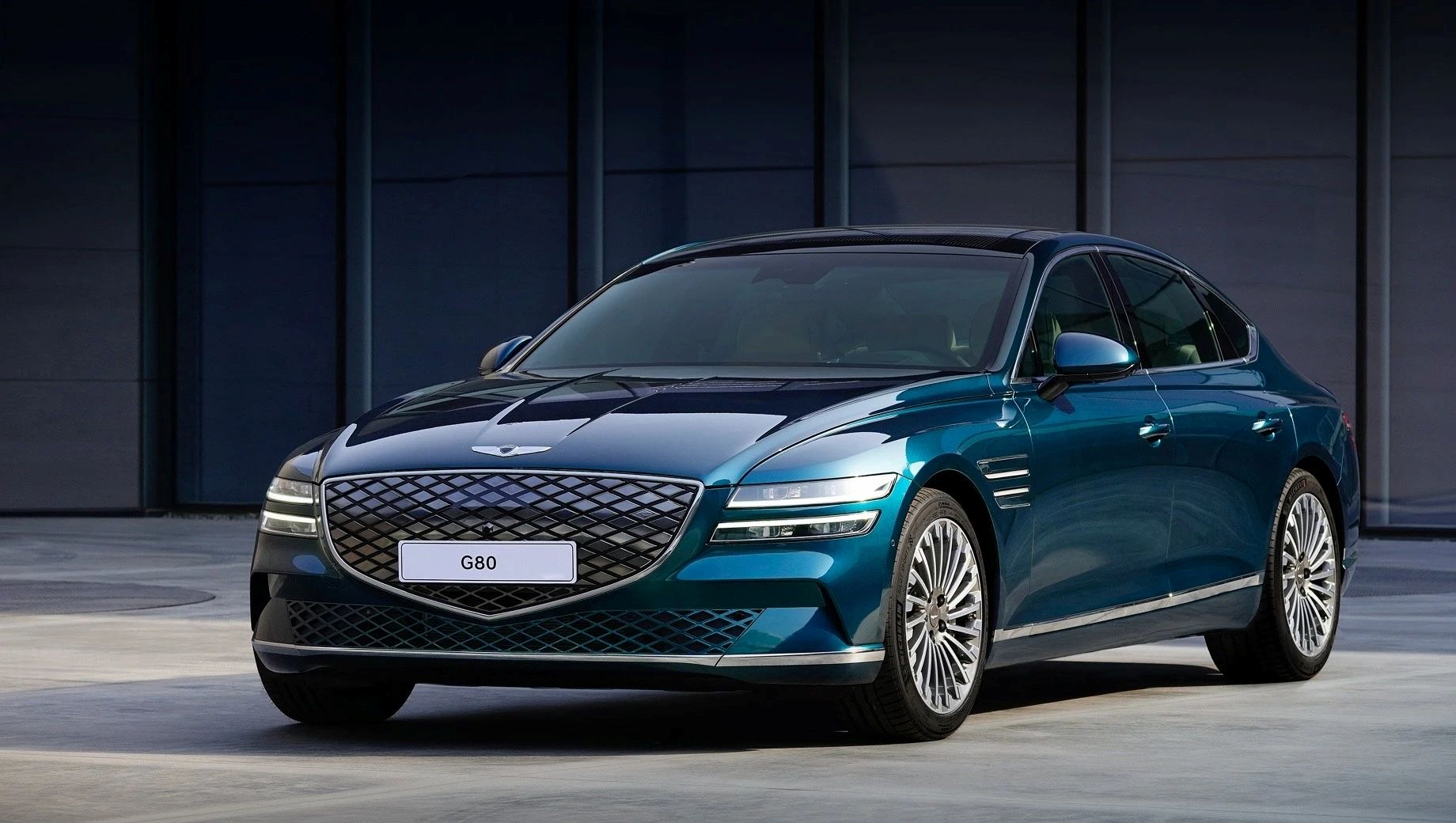
However, the GV60 is completely different. It is equipped with Hyundai Motor Group’s latest E-GMP pure electric platform, combined with Genesis’ experience in creating luxury car models over the past 20 years. When I received the test drive invitation for the Genesis GV60, I was a little excited.
Unique Design
When I first saw the GV60, the design with four corners, the enclosed air intake grille, the simple lines of the body, the headlights and taillights complementing each other, and the small tail wing at the rear caught my attention. Besides shaping aesthetics, it seems to tell everyone that I am a pure electric car.

There are two unique designs that catch my attention. On the one hand, the hood is designed integrally and extends to the fender area on both sides. The advantage is that the lines of the front face are more concise and smooth, but the disadvantage is that the repair cost will be higher when there is a collision on the side of the car. On the other hand, it adopts a brand new Genesis logo with exquisite carving pattern underneath Genesis, which is extremely rare in car logos.

Sitting inside, the sense of luxury is overwhelming. In response to the arrival of intelligence, a dual-screen is essential. However, regarding the performance of the infotainment system, I can give a conclusion now, plug in the data cable and turn on Carplay! A friendly reminder, there is no wireless Carplay.
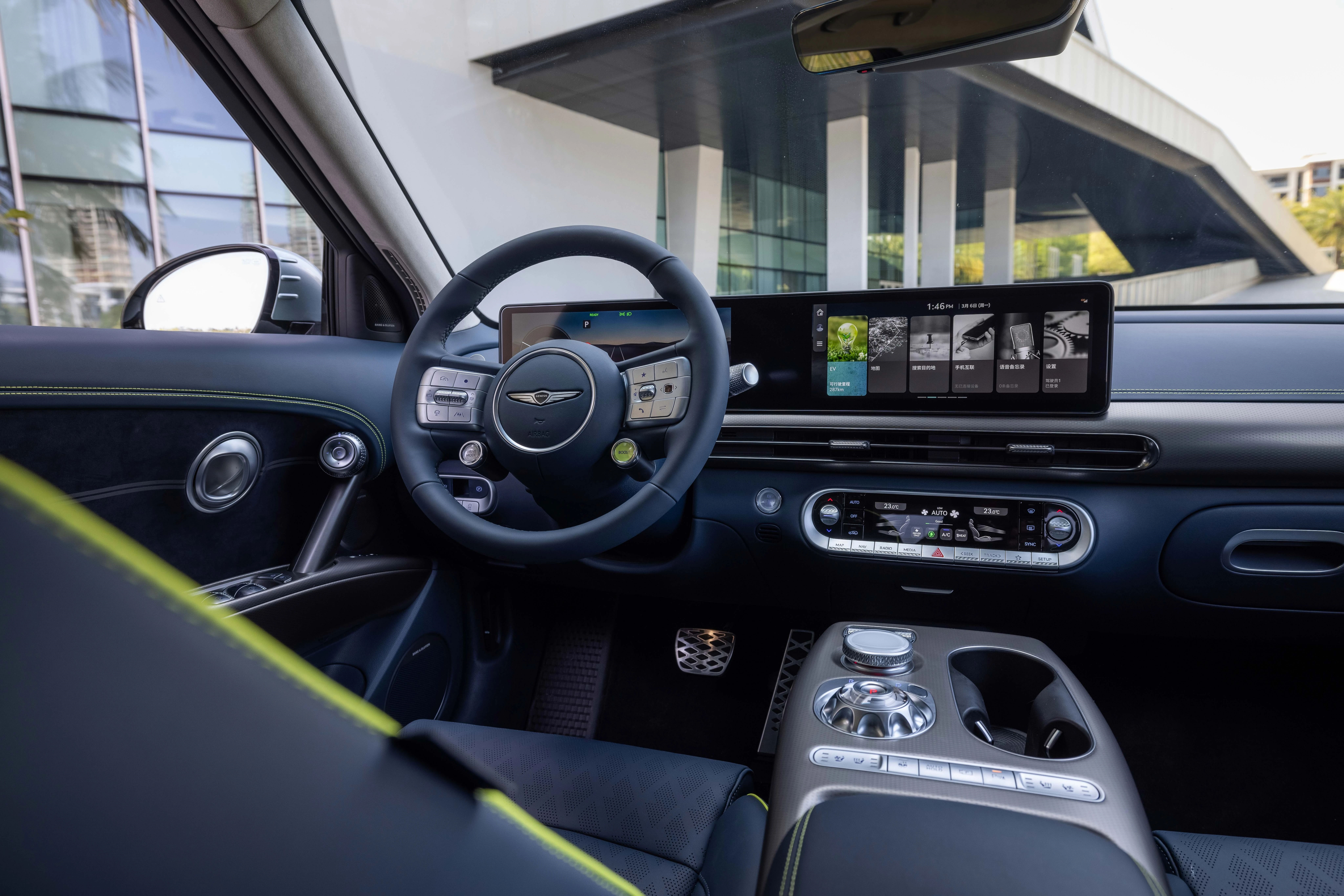
Of course, this can’t be blamed on Genesis, and it can only be said that the car’s OS in China is too powerful. It can be seen from the infotainment system that Genesis attaches great importance to the Chinese market. Third-party apps including QQ Music, Cloud Listening, etc., and navigation and voice all use Baidu’s solutions, even the voice assistant wake-up words are “XiaoDu, XiaoDu”.For Chinese consumers who have been exposed to new generation car infotainment systems, this system could indeed be difficult to use. The complex menu, multi-level interaction, icons and user interface seem to have gone back several years.

But, the GV60 has a lot of physical buttons to help you solve interaction problems. Below the central control screen, the air conditioning control area uses a combination of physical buttons and touch controls, and strong touch feedback makes it easy to control the air conditioning.
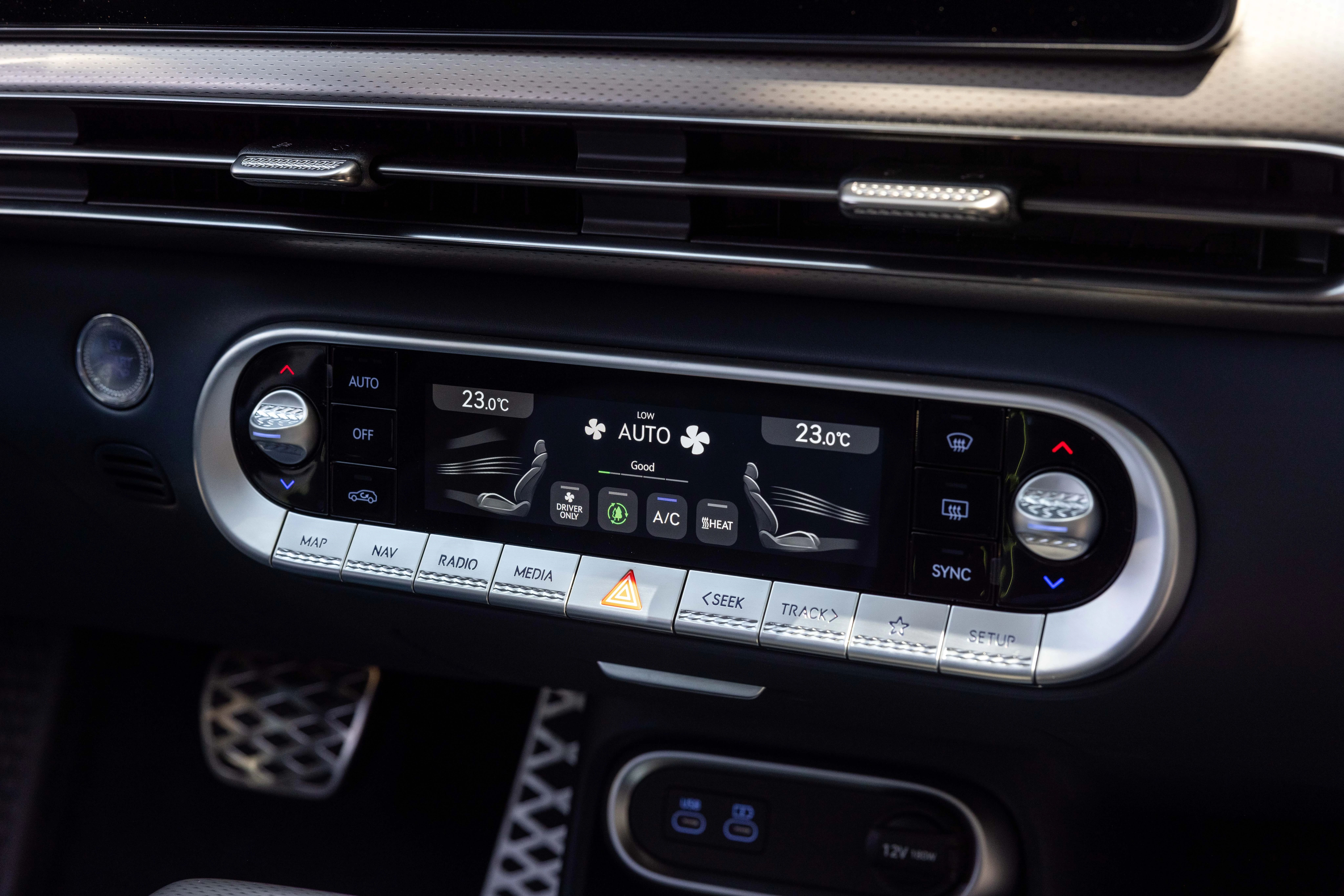
After looking at enough central control combinations like gear shift, wireless charging, cup holders, and armrest boxes, you can finally switch up the style by looking at the central control area of the GV60. First of all, it uses a large number of physical buttons, which I personally feel is a bit excessive. For example, the multimedia control and fingerprint recognition startup at the front can be completely integrated into the multifunctional steering wheel.

The white key behind is a multifunctional control button that can be handwritten, which I call the “handwritten mouse”. It works quite well in practice, but the multi-level structure still gives me a headache. The provided handwriting function may be more practical in Europe and America, but it is indeed a bit difficult to write Chinese characters on it.
Next is the most eye-catching gear shift area. Before starting up, the gear shift appears as a crystal ball shape. After you press the startup button, the gear shift rotates 180 degrees and has a great hand feel.

 Below the gear shift, there is a row of buttons that integrates frequently used functions such as seat ventilation and heating, steering wheel heating, and reversing camera. I tested the heating function on a day with over 20 degrees Celsius in Sanya and found that it can heat up both the seat and hands. The wireless charging area at the back also protrudes with the word “hot.” It is obvious that the wireless charging area of the GV60 is not ventilated since domestic wireless charging supports up to 50W+ and fan cooling. It is also a problem in terms of practicality, as Carplay must be transmitted with a physical data cable. Imagine that the aesthetics of the center console are destroyed by this cable.
Below the gear shift, there is a row of buttons that integrates frequently used functions such as seat ventilation and heating, steering wheel heating, and reversing camera. I tested the heating function on a day with over 20 degrees Celsius in Sanya and found that it can heat up both the seat and hands. The wireless charging area at the back also protrudes with the word “hot.” It is obvious that the wireless charging area of the GV60 is not ventilated since domestic wireless charging supports up to 50W+ and fan cooling. It is also a problem in terms of practicality, as Carplay must be transmitted with a physical data cable. Imagine that the aesthetics of the center console are destroyed by this cable.
Oh, by the way, it was my first time encountering the drawer-style glove compartment.
Just when I was about to criticize the lack of storage space under the center console, I found that the GV60 center console adopts a through design that leads directly to the back row. This further improves the space utilization rate, and the advantages of the pure electric platform are also evident. At the same time, I was curious about how the rear air outlet is handled. Later, I found that the GV60 rear air outlet is on the B-pillar side. The rear doors are equipped with cup holders and physical buttons for seat heating, and there is a manually operated sunshade on the car window.
The comfort of the rear seats deserves a high score, although it is a compact SUV, the 2900mm wheelbase still provides ample space inside the car. Legroom is occupied by the length of the seat cushion, and the angle formed by the seat cushion and the backrest is also very comfortable. The seat is neither too soft nor too hard, just right. If I have to nitpick, I would say that the leg space under the seat is not friendly to people over 180cm tall.The 10+ electric adjustments for the front seats are just the basics. Adjusting the seat cushion angle will cause the backrest to move in sync, always maintaining a comfortable angle. The front passenger seat also features comfortable access. After driving for more than an hour, the seat massage will turn on automatically. It’s worth noting that the seats also change according to the driving mode. In sport mode, the seats will tighten to provide better wrapping.
The adjustment button for the rearview mirror is located on the front door handle, a clever and unique design that I really like.

The unique, beautiful, novel, and practical design made me love this GV60 even more.
Get Moving
On the way from Sanya Airport to the hotel, the pickup car was the electric version of G80. One thing that impressed me the most after an hour’s drive was the NVH. It reminded me of the first time I sat in a Lexus, the car was particularly quiet. I even doubted my own ears sitting in the G80, so I used a watch to measure the noise at 120 km/h, which was less than 60 decibels, a very surprising result.
Sure enough, the same performance is replicated in the GV60. However, as an SUV model, the wind noise of the GV60 is still much higher than that of the G80. Even so, the NVH control of the GV60 is among the best in its class.
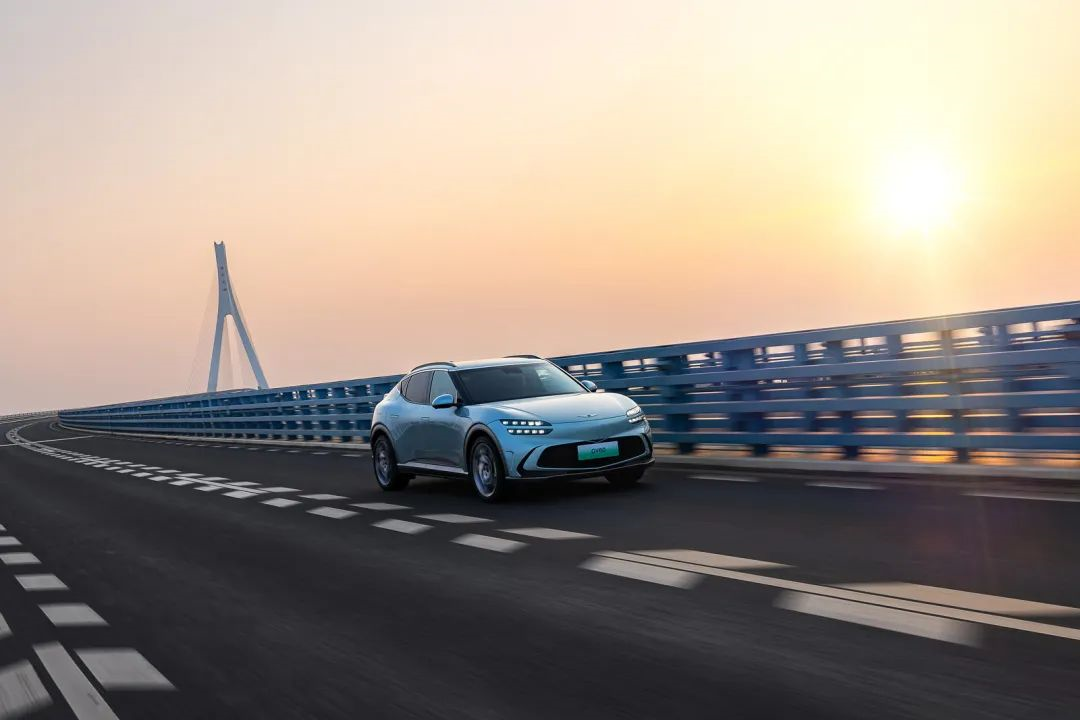
The test-driven GV60 is the four-wheel-drive flagship performance version, with much more power than the regular four-wheel-drive GV60. The dual-motor output peak power can reach 320 kW, and in Boost mode, the peak output power can reach 360 kW, and the maximum output torque can reach 700 N·m.
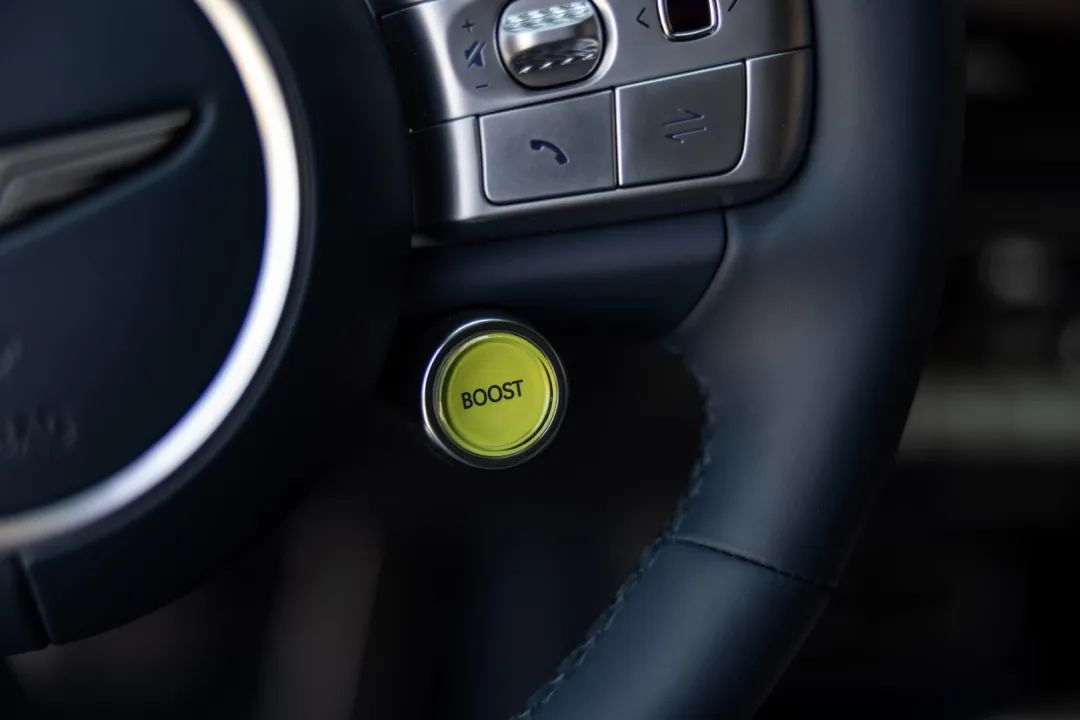 Boost mode is not just a simple power increase of 40 kW, the throttle will become very aggressive, instantly outputting maximum torque. Even if not in starting state, the extremely strong push-back feeling can be experienced when Boost mode is enabled. In addition to the Boost mode, the GV60 also offers drift mode, the specific way of enabling it is too complicated for me to remember…
Boost mode is not just a simple power increase of 40 kW, the throttle will become very aggressive, instantly outputting maximum torque. Even if not in starting state, the extremely strong push-back feeling can be experienced when Boost mode is enabled. In addition to the Boost mode, the GV60 also offers drift mode, the specific way of enabling it is too complicated for me to remember…
Besides the exhilarating acceleration experience of the Boost mode, on a deeper level, GV60 seems to be showcasing its excellent tri-electric system. Unfortunately, only the top-of-the-line models have the Boost mode, and the peak power of the two-wheel-drive model is only 168 kW, while the peak power of the regular four-wheel-drive model is only 233.9 kW. Luckily, the peak torque of the four-wheel-drive model reaches 605 N·m, and I believe there will still be surprises when accelerating.
The button for starting the Boost mode is in the bottom right corner of the steering wheel, which is somewhat reminiscent of Ferrari. In order to render a sense of combat, there are also two paddles behind the steering wheel of GV60. Of course, the two paddles are not used for gear shifting, but for adjusting kinetic energy recovery.

The kinetic energy recovery is divided into four modes: Auto, 1, 2, and 3. If you continue to flip the paddles, it will switch to single-pedal mode. If you hold down the left paddle, the vehicle will continue to decelerate until it comes to a stop, which is similar to Cadillac Lyriq.
The only thing I didn’t really like about driving GV60 was the steering wheel, which was a bit heavy, and I couldn’t find the adjustment option. However, the steering was very precise and linear. The test drive route was a combination of expressways and mountain roads, and the Genesis coach was driving really fast, which made driving very exciting for me, but a bit tough for the camera guy in the front passenger seat and the lady in the back seat.
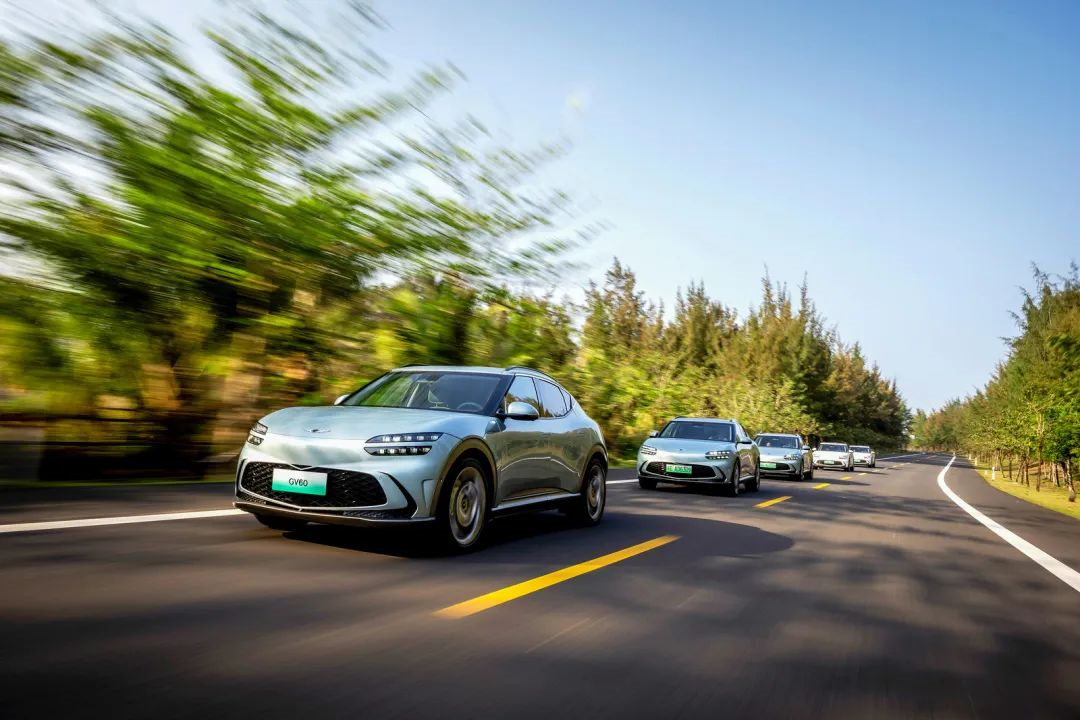
The overall chassis tuning is a bit on the hard side, and it feels very tight when driving, filtering out the fine bumps on the road very well, and the suspension also handles the road joints well. After all, it comes with active CDC electromagnetic suspension, and driving feels great.On the hardware side, the combination of front MacPherson and rear five-link suspension is adopted. Although a lateral stabilizer bar is also added to the front suspension, I feel a bit tilted on mountain roads, after all, the weight of GV60 is close to 2.2 tons.
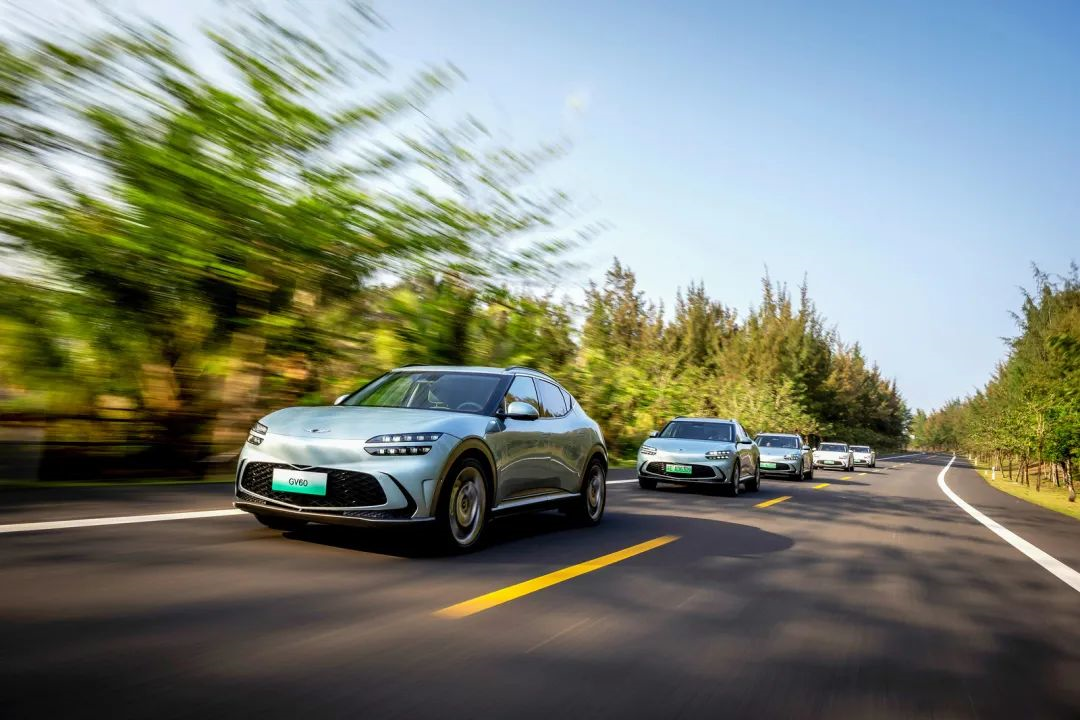
The dynamic performance of GV60 is quite wonderful. It’s hard to tell if it’s for grocery shopping or exercise. Driving it slowly and comfortably, the suspension and seats will make you very comfortable. However, the Boost button on the steering wheel is constantly reminding me that this is a car with 0-100 km/h acceleration of 3.9 seconds. When I decide to go crazy, I feel that this car cannot withstand the violent inner heart.
Is it the best choice to buy a normal four-wheel drive GV60?
In terms of endurance, due to the short-distance high-speed and mountainous road test drive route, my energy consumption performance was only 9 kWh/100 km when I returned, which clearly has no reference value. However, in the simple experience one day in advance, the energy consumption was controlled at around 20 kWh/100 km, roughly estimating that the 77-degree battery can run up to 350 km when fully charged, which can be considered a medium and fair score.
Fortunately, GV60 is based on the 800 V platform, which can basically consume full power on third-party charging piles in China, so it still has a big advantage in charging efficiency compared to models built on the 400 V platform.
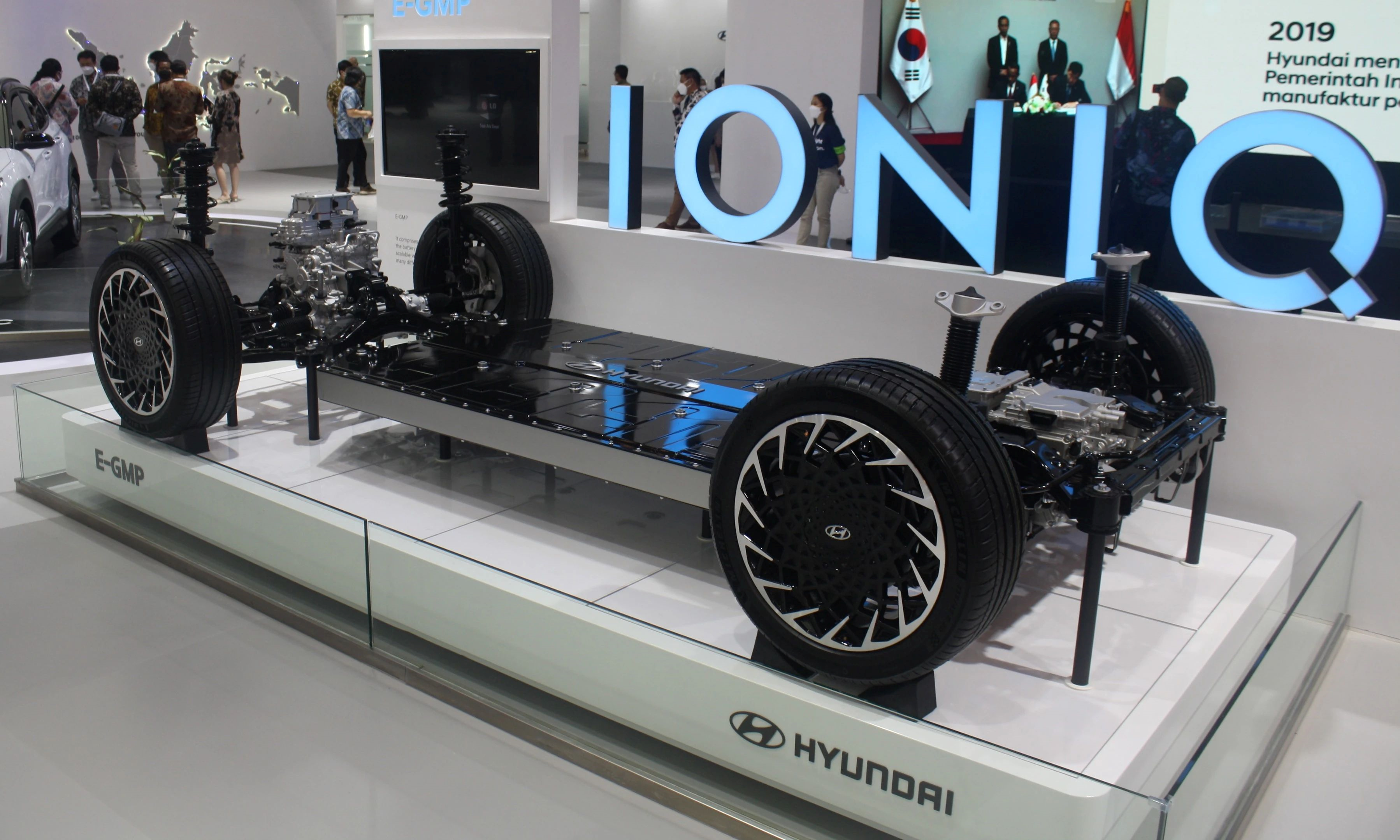
Finally, let’s talk about assisted driving. The basic assisted driving capability is very strong, but the startup method is too complicated. In terms of the ability of ACC and LCC, it is absolutely not weak. Longitudinal control is very smooth, especially when following closely at low speeds, there will be no sudden acceleration or deceleration. The LCC can maintain the middle of the lane very stably. Although the efficiency of changing lanes by turn signal is not high, the process is very smooth.
However, this GV60 is still unable to cope with large curvature bends, and what makes me even more sad is that the startup of the assisted driving of this car is too complicated. At least two buttons need to be pressed to start it. Why do I say at least? Because, in my short experience, I am not sure what is the correct startup method. The complexity is similar to Cadillac’s SuperCruise.### Conclusion
The GV60 feels very well-designed and balanced. All the advantages of traditional brands are preserved, including excellent power and chassis performance, comfortable seats, highly recognizable exterior design, and many interior design details. In terms of vehicle engineering, the GV60 is outstanding.
However, there are also some noticeable downsides. The menu hierarchy of the GV60’s infotainment system is too complicated, and while Carplay can solve almost everything, the wired one makes it difficult to determine where to put your phone. Additionally, the plethora of physical buttons seems to be somewhat out of touch with the times.
As a global model, the GV60 will not debut in China until 2023, and it will face Chinese consumers’ picky eyes and much greater competition than overseas markets. It will not be easy for the GV60 to establish a foothold in the domestic market.
If Genesis can accept becoming a niche luxury brand, that would be great. I believe there is a small group of people who appreciate Genesis’s luxury and the brand’s style.
This article is a translation by ChatGPT of a Chinese report from 42HOW. If you have any questions about it, please email bd@42how.com.
